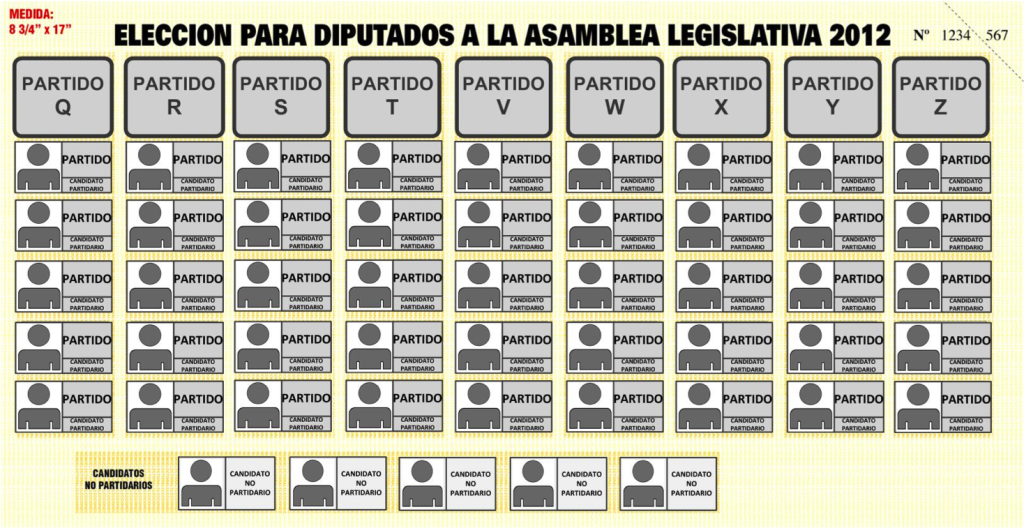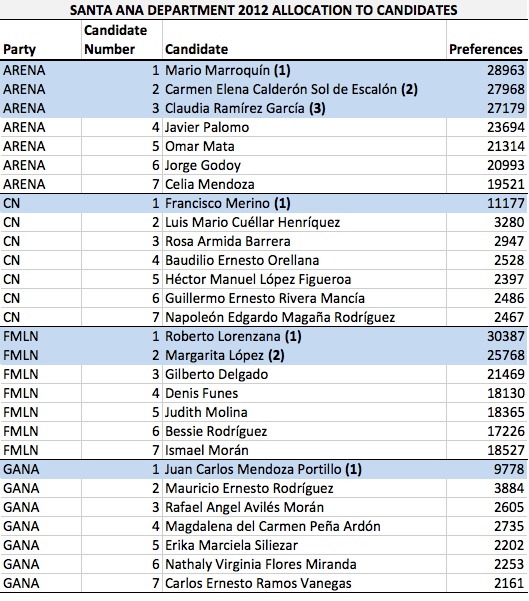El Salvador has utilized 3 electoral systems to allocate the 84 seats in the Legislative Assembly (Asamblea Legislativa) since 1990.
EL SALVADOR 1 (1991-2003)
Under this coexistence electoral system, El Salvador allocated 64 seats within departments and 20 seats at the national level. Voters cast a single vote for a closed party list that was used twice–once for the departmental allocation and one for the national allocation.
The following table shows the apportionment of seats in El Salvador from 1990-2018. Each department is guaranteed a minimum of 3 seats.
Seats were allocated within departments and at the national level by the largest remainder system of proportional representation with a Hare quota. In both the departmental and national allocations, parties received seats first for full multiples of the Hare quota–votes divided by seats. Any seats left were allocated in descending order of remainder votes (i.e. votes that were not already used towards a full Hare quota seat).
As party lists were closed, seats won were allotted to candidates in list order.
Coalitions (i.e. apparentements) were legal but the parties could present joint candidates under a single banner on the ballot if they united lists across all departments. Otherwise, the distribution of seats was based on the combined vote of their separate lists with the allocation of any seats won to specific candidates based on the coalition’s pre-election agreement.
EL SALVADOR 2 (2006-9)
This electoral system eliminated the allocation at the national level. Instead, all seats were allocated within departments. The above table shows the apportionment of seats for the two elections held under this system. Otherwise, the electoral system remained the same.
EL SALVADOR 3 (2012-)
The major change from the previous electoral system was the elimination of closed lists in favor of open lists. In addition to voting for a party, voters may now express preferences for as many candidates as there are mandates in the department. Parties cannot run more candidates than seats. Voters may only vote for candidates on different lists if there is a coalition between the two parties.
Independent candidacies were permitted for the first time with each independent candidate treated effectively like a separate party list.
In practice, voters may cast their ballot in many different ways. First, they can place an X over the party list symbol but express no preferences. Second, they can places Xs over the party list symbol and as many individual candidates within the list as they prefer. Third, they can place Xs over individual candidates within a single party or coalition. In this case, the ballot is still counted as for the party. Finally, the voter may place a big X over all of a single party’s candidates, which is also counted as a vote for that party.
The following is a sample ballot from the TSE (Tribunal Supremo Electoral) for 2012:

The allocation of seats to parties or coalitions remains the same–the largest remainder system with a Hare quota. However, El Salvador now awards the seats gained by each party or coalition to candidates in descending order of their preference votes.
The following table shows the allocation to parties within Santa Ana Department in 2012 (there were no independent candidates or coalitions) utilizing the largest remainder system with a Hare quota. ARENA and FMLN first won 2 seats apiece for full multiples of the Hare quota. The last 3 seats went to CN, ARENA and GANA because these parties has the largest remainder votes (i.e. not used to win a seat for a full quota).
 Seats were then allocated to specific candidates within seat-winning parties based on preference votes, as shown in the following table. The winning candidates are highlighted in blue with the allocation order indicated in boldface after the candidate’s name. In this particular example, the highest ranked candidates also received the most preference votes, so the use of open lists did not make a difference.
Seats were then allocated to specific candidates within seat-winning parties based on preference votes, as shown in the following table. The winning candidates are highlighted in blue with the allocation order indicated in boldface after the candidate’s name. In this particular example, the highest ranked candidates also received the most preference votes, so the use of open lists did not make a difference.


